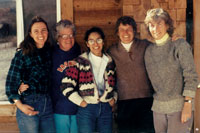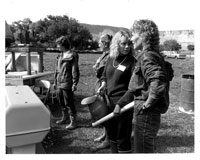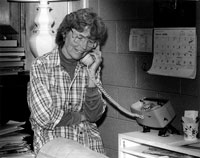“We were doing eco-tours before they were called that, and before anyone else was doing it. We got press because of it.” “We” were the founders of Canyonlands Field Institute, Robin Wilson and Karla VanderZanden. I was interviewing Karla at the Wake ‘n’ Bake in Moab as part of this series on people whose creativity, love of Moab, and willingness to sacrifice for a dream pulled Moab through the uranium bust years into the present. Robin and Karla were part of that group.
In 1982, Karla was sitting in the student union at Utah State University (USU) with friends also destined to be part of the Moab community--Alice Drogin, Tim Graham, Audrey Graham, and Kate Kitchel. Discussing their career plans, Karla said she’d like to bring her love of river running, camping, and outdoor education together. Kate said, “You should meet Robin Wilson in Moab.” Kate knew Robin had gone to H. K. Hancock at the USU extension office to discuss using their facilities for an outdoor education program. She had also considered using the Professor Valley ranch which was her and her husband Bates Wilson’s home.
 |
Early staff of Canyonlands Field Institute: Sue Bellagamba, Marian Ottinger, Angela Bautista, Karla VanderZanden, Robin Wilson |
In May of 1983, Robin and Karla met for coffee on Robin’s front porch. Watching the sun come up, they discussed their ideas for getting people into the Moab area and raising their understanding of it. Bates had died earlier that year which left Robin alone to run the ranch and raise two daughters. Karla was still a West Water River Ranger on the Colorado and going to graduate school, but by June 5, of 1984, Karla had graduated, and they incorporated as Canyonlands Field Institute (CFI).
Naming the Institute was an adventure. Robin, Karla, and Barry Miller, Karla’s husband, ran West Water as a daily, but they put in at Loma, Colorado because the West Water Ranger Station was flooded out. Normally a two to three day trip, they ran from Loma to Cisco, Utah in a day. With the river running at 60,000 cubic feet per second (cfs), when normal for spring run off might be 20,000 to 35,000 cfs, they must have been busy navigating, but they still found time to come with up the name.
“CFI has always had the same goal--to establish a meaningful connection between kids and the Colorado Plateau. That includes the peoples of this area as well as the science”, Karla explained. “It was important to Robin that we be gracious hosts to the people who came to the Colorado Plateau and those who lived here. We wanted to dialogue in a softer way about caring for the place and wanted to emphasize relationship. Robin had a saying, ‘Any kind of footwear is welcome on this porch."
 |
| Karla VanderZanden, Alice Knee, Anne Wilson, Robin Wilson |
That also sounds a lot like Bates, Robin’s husband and retired superintendent of Arches National Park. In Down the Colorado, Jim Carrier recorded a conversation he had with Robin. “‘There were a couple of years, after Bates died, when I wondered whether I should be doing something to preserve an attitude. Bates was not a person who wrote things down. There is very little of his legacy on paper.’” And so she formed CFI, in part, as “a carrying on of an attitude, of wanting this country understood and enjoyed . . .” the way Bates had understood it and shared it--letting it speak for itself.
“Gracious,” was the first word Alice Drogin used to describe Robin when I asked how she remembered her. She said she also admired her intelligence and integrity and saw her as a role model. For Karla, she was a life, as well as career mentor. “She could be direct in that capacity, trying to smooth off some my hard edges.”
Mentor, role model, business woman, outdoor educator and guide were all roles Robin filled with aplomb, but Robin was first a mother, according to Karla. “She had two teen-age daughters when Bates died, and while she donated many unpaid hours to CFI, the girls came first.”
Robin’s idea of a nightly, multi-projector, slide show featuring the canyon country came together with the production of The Canyon’s Edge. It was written and narrated by Terry Tempest Williams, the photos were by Tom Till and Bruce Hucko who also programmed it. Originally, it required eight slide projectors, and was shown in the big barn that has since become Eddie McStiff’s. Christy Williiams, now program director for KZMU and others, took the unwieldy show on the road to communities of Eastern Utah and the Western Slope of Colorado.
 |
| Robin Wilson on the phone. |
Early on, CFI presented programs for adults as well as children and were very successful at it. They offered classes with credit from USU taught by such local experts as Tom Till and Steve Mulligan--photography, wild flower identification--Lee Goodman and desert ecology--Tim Graham.
Robin died May 3, 1991 of cancer at the age of 56. Her death was a blow to the organization and to all who knew her. Still, CFI survived, and today is a healthy non-profit carrying on in her spirit of letting people discover the desert and helping them appreciate what they find.
Remembering Robin Wilson nearly thirty years after their initial meeting, Christy Williams recalls, “Robin was one of the first people I met on moving to Moab, so I associated her with the place. She was a good person to imprint on since, like Moab, she embodied spaciousness, gravity [as in grounded] and peace. Everything good you could say about wild places, you would get in a micro dose being in Robin’s company.”
Sue Bellagamba also recalls how everyone--neighboring ranchers, east coast visitors and young idealists--felt at home on the porch in Professor Valley. But it wasn’t as though she spent her days sitting there, for she often had to get up and irrigate before driving the River Road into town to be at the CFI office at 8:00. Robin combined the grace and manners of her east coast upbringing and Smith College education with the roll-up-your-sleeves and don’t-shy-from-the-dirty-work attitudes of the West.
Finally, I will let Robin speak for herself in this letter she wrote to Theresa King, President of the Moab Chamber of Commerce, upon being named Citizen of the Year for 1989...
January 26, 1990
Dear Theresa:
I write to you as spokeslady for the Chamber, but with those in mind who had to deal with the fine roster of nominations for the Citizen of the Year Award.
First, my very sincere thanks for this honor. It is still an overwhelming thought for me. It is an incentive. It is a statement of caring and trust. In that light, it is humbling.
Secondly, it says to me something about the values and privileges of life in a small town. In larger places, you lose the connectedness of lives. Here, we are all woven together in many ways.
It is the way life is supposed to be.If good things can happen anywhere, they will happen in Moab
because of this interdependency.
Sincerely,
Robin
|
|


